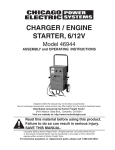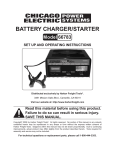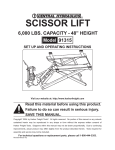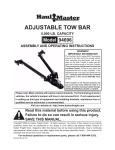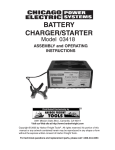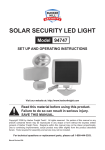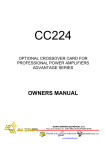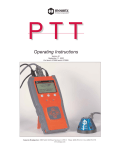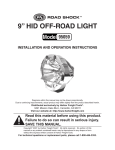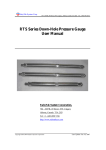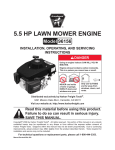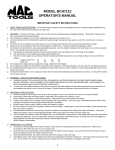Download Harbor Freight Tools 3418 User's Manual
Transcript
BATTERY CHARGER/STARTER 3418 ASSEMBLY AND OPERATION INSTRUCTIONS Visit our website at: http://www.harborfreight.com Read this material before using this product. Failure to do so can result in serious injury. Save this manual. Copyright© 2005 by Harbor Freight Tools®. All rights reserved. No portion of this manual or any artwork contained herein may be reproduced in any shape or form without the express written consent of Harbor Freight Tools. Diagrams within this manual may not be drawn proportionally. Due to continuing improvements, actual product may differ slightly from the product described herein. Tools required for assembly and service may not be included. For technical questions or replacement parts, please call 1-800-444-3353. Manual Revised 06k, 09h Specifications Input 120 V~, 60 Hz, 2.2 A Output 12 VDC 12 VDC 6 VDC Engine Start - - - - Battery Leads 10* A Power Cord 2* A 10* A 55 A Weight 6’ 7” x 16 AWG 6’ 5” x 18 AWG (3-Prong Grounded Plug) 10 lb. *Amperage is only present when the unit is connected to a battery or in START mode. Important Safeguards Important Safety instructions 1. “SAVE THESE INSTRUCTIONS” - This manual contains important safety and operating instructions for battery charger Model: 03418. 2. Do not expose charger to rain or snow. 3. Use of an attachment not recommended or sold by the battery charger manufacturer may result in a risk of fire, electric shock, or injury to persons. 4. To reduce risk of damage to electric plug and cord, pull by plug rather than cord when disconnecting charger. An extension cord should not be used unless absolutely necessary. 5. Use of improper extension cord could result in a risk of fire and electric shock. If extension cord must be used, make sure: a. That pins on plug of extension cord are the same number, size, and shape as those of plug on charger. b. That extension cord is properly wired and in good electrical condition. c. That wire size is large enough for AC ampere rating of charger. MINIMUM AWG WIRE SIZE FOR EXTENSION CORDS FOR THIS BATTERY CHARGER AC input Length of cord, m AC input Length of cord, m Current I, A AWG size of cord Current I, A AWG size of cord 25 50 100 150 25 50 100 150 0<I<2 18 18 18 16 6<I<8 18 16 12 10 2<I<3 18 18 16 14 8 < I < 10 18 14 12 10 3<I<4 18 18 16 14 10 < I < 12 16 14 10 8 4<I<5 18 18 14 12 12 < I < 14 16 12 10 8 5<I<6 18 16 14 12 14 < I < 16 16 12 10 8 6. Do not operate this charger with a damaged cord or plug – replace the cord or plug immediately. 7. Do not operate charger if it has received a sharp blow, been dropped, or otherwise damaged in any way; take it to a qualified serviceman. SKU 03418 For technical questions, please call 1-800-444-3353. Page 2 8. Do not disassemble charger; take it to a qualified serviceman when service or repair is required. Incorrect reassembly may result in a risk of electric shock or fire. 9. To reduce risk of electric shock, unplug charger from outlet before attempting any maintenance or cleaning. 10. WARNING - RISK OF EXPLOSIVE GASES. a. Working in the vicinity of a lead-acid battery is dangerous. Batteries generate explosive gases during normal battery operation. For this reason, it is of utmost importance that each time before using your charger, you read this and follow the instructions exactly. b. To reduce the risk of the battery explosion, follow these instructions and those published by battery manufacturer and manufacturer of any equipment you intend to use in vicinity of battery. Review cautionary markings on these products and on engine. 11. PERSONAL PRECAUTIONS a. Someone should be within range of your voice, or close enough to come to your aid, when you work near a lead-acid battery. b. Have plenty of fresh water and soap nearby in case battery acid contacts skin, clothing, or eyes. c. Wear complete eye protection and clothing protection. Avoid touching eyes while working near battery. d. If battery acid contacts skin or clothing, wash immediately with soap and water. If acid enters eye, immediately flood with running cold water for at least 10 minutes and get medical attention immediately. e. NEVER smoke or allow a spark or flame in vicinity of battery or engine. f. Be extra cautious to reduce risk of dropping a metal tool onto battery. It might spark or short-circuit battery or other electrical part that may cause an explosion. g. Remove personal metal items such as rings, bracelets, necklaces, and watches when working near a lead-acid battery. A lead-acid battery can produce a short-circuit current high enough to weld a ring or the like to metal, causing a severe burn. h. Use this charger for charging LEAD-ACID batteries only. It is not intended to supply power to a low voltage electrical system other than in an automotive application. Do not use battery charger for charging dry-cell batteries that are commonly used with home appliances. These batteries may burst and cause injury to persons and damage to property. i. NEVER charge a frozen battery. 12. PREPARING TO CHARGE BATTERY a. If it becomes necessary to remove the battery from the vehicle to charge, always remove grounded terminal from battery first. Make sure all accessories in the vehicle are off, so as not to cause an arc. SKU 03418 For technical questions, please call 1-800-444-3353. Page 3 b. Be sure area around battery is well ventilated while battery is being charged. Gases can be forcefully blown away, by using a piece of cardboard or other non-metallic material such as a fan. c. Clean battery terminals. Be careful to keep corrosion from coming in contact with eyes. d. Add distilled water in each cell until battery acid reaches level specified by battery manufacturer. This helps purge excessive gas from cells. Do not overfill. For a battery without cell caps, carefully follow manufacturer’s recharging instructions. e. Study all battery manufacturer’s specific precautions such as removing or not removing cell caps while charging and recommended rates of charge. f. Determinate voltage of battery by referring to car owner’s manual and make sure that output voltage selector switch is set at correct voltage. If charger has adjustable charge rate, charge battery initially at lowest rate. 13. CHARGER LOCATION a. Locate charger as far away from battery as the DC cable permits. b. Never place charger directly above battery being charged; gases from battery will corrode and damage charger. c. Never allow battery acid to drip on charger when reading gravity or filling battery. d. Do not operate charger in a closed-in area or restrict ventilation in any way. e. Do not set a battery on top of charger. 14. DC CONNECTION PRECAUTIONS a. Connect and disconnect DC output clips only after setting any charger switches to off position and removing AC cord from electric outlet. Never allow clips to touch each other. b. Attach clips to battery and chassis as indicated in 15 (e), 15 (f), 16 (b), and 16 (d). 15. Follow these steps when battery is installed in vehicle. A spark near battery may cause battery explosion. To reduce risk of a spark near battery: a. Position AC and DC cords to reduce the risk of damage by hood, door, or moving engine parts. b. Stay clear of fan blades, belts, pulleys, and other parts that can cause injury to persons. c. Check polarity of battery posts. POSITIVE (POS, P, +) battery post usually has larger diameter than NEGATIVE (NEG, N, -) post. d. Determine which battery post is grounded (connected) to the chassis. If negative post is grounded to chassis (as in most vehicles), see (e). If the positive post is grounded to the chassis, see (f). e. For negative-grounded vehicle, connect POSITIVE (RED) clip from battery charger to POSITIVE (POS, P, +) ungrounded post of battery. Connect NEGATIVE (BLACK) clip to vehicle chassis or engine block away from battery. Do not connect clip to the SKU 03418 For technical questions, please call 1-800-444-3353. Page 4 carburetor, fuel lines, or sheet-metal body parts. Connect to a heavy gauge metal part of the frame or engine block. f. For positive-grounded vehicle, only connect NEGATIVE (BLACK) clip from battery charger to NEGATIVE (NEG, N, -) ungrounded post of battery. Connect POSITIVE (RED) clip to vehicle chassis or engine block away from battery. Do not connect clip to the carburetor, fuel lines, or sheet-metal body parts. Connect to a heavy gauge metal part of the frame or engine block. g. When disconnecting charger, turn switches to off, disconnect AC cord, remove clip from vehicle chassis, and then remove clip from battery terminal. h. See operating instructions for length of charge information. 16. Follow these steps when battery is outside vehicle. A spark near battery may cause battery explosion. To reduce risk of a spark near battery: a. Check polarity of battery posts. POSITIVE (POS, P, +) battery post usually has larger diameter than NEGATIVE (NEG, N, -) post. b. Attach at least a 24-inch-long 6-gauge (AWG) insulated battery cable to NEGATIVE (NEG, N, -) battery post. c. Connect POSITIVE (RED) charger clip to POSITIVE (POS, P, +) post of battery. d. Position yourself and free end of cable as far away from battery as possible- then connect NEGATIVE (BLACK) charger clip to free end of the cable. e. Do not face battery when making final connection. f. When disconnecting charger, always do so in the reverse sequence of connecting procedure and break first connection while as far away from the battery as practical. g. A marine (boat) battery must be removed and charged on shore. To charge it on board requires equipment specially designed for marine use. Save these Instructions Specific Safety Rules for the Battery Charger 1. Maintain labels and nameplates on the Battery Charger. These carry important information. If unreadable or missing, contact Harbor Freight Tools for a replacement. 2. Always wear safety impact eye goggles and heavy work gloves when using the Battery Charger. Using personal safety devices reduce the risk for injury. Safety impact eye goggles and heavy work gloves are available from Harbor Freight Tools. 3. Maintain a safe working environment. Keep the work area well lit. Make sure there is adequate surrounding workspace. Always keep the work area free of obstructions, grease, oil, trash, and other debris. Do not use a power tool in areas near flammable chemicals, dusts, and vapors. Do not use this product in a damp or wet location. 4. Avoid unintentional starting. Make sure you are prepared to begin work before turning on the Battery Charger. SKU 03418 For technical questions, please call 1-800-444-3353. Page 5 5. Always unplug the Battery Charger from its electrical outlet before connecting its cables to a battery, or performing and inspection, maintenance, or cleaning procedures. 6. Keep extension cord off wet ground and away from water. 7. Use this Battery Charger with lead/acid batteries only. When charging a maintenancefree battery, always monitor the progress of the charge by viewing the ammeter. Do not over charge a maintenance-free battery. 8. Do not attempt to charge non-rechargeable or defective batteries. 9. Keep connections and cable clamps clean and free from corrosion. 10. Never simultaneously charge several batteries. 11. Do not discard used batteries in the trash. Properly recycle according to local environmental codes. 12. WARNING: This product contains or, when used, produces a chemical known to the State of California to cause cancer and birth defects or other reproductive harm. (California Health & Safety Code § 25249.5, et seq.) 13. WARNING: People with pacemakers should consult their physician(s) before using this product. Electromagnetic fields in close proximity to a heart pacemaker could cause interference to or failure of the pacemaker. 14. Risk of Explosion! • If you detect gas, do not switch off the unit. Do not disconnect the charging clamps. Immediately ventilate the room by opening windows and doors. Do not switch on an electrical fan. When the air has cleared of gas, unplug the unit from the electrical outlet. • Charge the battery in a well-ventilated area. • To prevent sparking due to electrostatic discharge, never wear clothes made of synthetic materials when charging the battery. • Avoid creating or working around any flames or sparks; flames or sparks can ignite the gasses caused by charging and cause an explosion. Unpacking When unpacking, check to make sure that the item is intact and undamaged. If any parts are missing or broken, please call Harbor Freight Tools at the number on the cover of this manual as soon as possible. SKU 03418 For technical questions, please call 1-800-444-3353. Page 6 Setup About Charging Batteries Batteries draw as much power as they need from the charger. The charger does not force current into the battery. When a battery is close to dead or very low charged, it will want to draw more current. When a dead or low battery is charged, the charger’s ammeter will register at the high end. As the battery charges, the reading will move down toward the low end, resting on zero, when the battery is fully charged. See FIGURE 1 below. Note: The ammeter shows the amount of current being drawn from the charger. It does not show what the charger is capable of delivering. When the battery is fully charged and registering zero on the ammeter, a small trickle charge will continue to move from the charger to the battery. If you do not disconnect the charger from the battery, eventually the heat build up from the trickle charge will cause the battery acid to boil and overcharge the battery causing damage to the battery. You must constantly monitor battery charging progress and if battery gets warm, stop charging it immediately. Note: This charger is not recommended for batteries with a built in Hydrometer eye. The reading of the built in eye will conflict with the ammeter readings. Do not plug this charger in until directed to do so in the following pages of this manual. Preparing the Battery 1. If necessary, remove the battery from the vehicle to charge it. When removing the battery, always remove the grounded battery cable first. Reminder: The vehicle’s engine must be OFF when removing, replacing, or charging a battery. REV 08f, 09h SKU 03418 For technical questions, please call 1-800-444-3353. Page 7 2. If necessary, add distilled water to the battery cells before charging. Read and follow the battery manufacturer’s instruction manual. Never add water to a battery while attached to a charger, or in close proximity to the charger. Do not overfill. 3. Clean battery terminals. 4. Check the battery manufacturer’s instructions on whether or not to have the cell caps on when charging. If not stated, leave the cell caps on. CHARGING BATTERIES Caution: Do not overcharge maintenance-free batteries. 1. Place the Battery Charger and battery in a well-ventilated area. 2. Determine the voltage of the battery from the battery labels. 3. Push the Charge / Start switch to the Charge mode. Push the Select Setting switch to the desired battery voltage: 6V or 12V. 4. If charging a battery while in a vehicle, leave the hood open and do not leave the charger unattended. Separate the charger and battery as much as possible. 5. With the Battery Charger unplugged, connect the positive (red) Cable Clamp (2) to the positive terminal of the battery. If charging a battery mounted in a vehicle, first remove the vehicle’s red cable from the battery; otherwise damage may occur to the vehicle’s electrical system. If in doubt, refer to the vehicle’s service manual. 6. Connect the negative (black) Cable Clamp (2) to the negative terminal of the battery. 7. Plug the Power Cord (3) into the electrical outlet. 8. Note: If the Red Reversed Connection LED is lit, the cables are connected to the wrong terminals of the battery. If this happens, immediately switch off the charger, unplug it, and switch the connections. For a quick charge assist to enable starting the engine, charge for 5 to 10 minutes. For a full charge, leave the Battery Charger running. If the charger is in manual mode, it must be monitored and shut off when the battery is charged; NEVER leave a battery unattended while charging. If the charger is in automatic mode, when the battery is fully charged the Battery Charger will automatically cycle through a trickle charge, and the green LED will remain lit. Optionally, only with the battery removed from the vehicle and the charger in automatic mode, the Battery Charger can be left on while connected to the battery. When the battery becomes weak, the Battery Charger will automatically turn on. When the battery is once again charged, the Battery Charger will automatically shut off. It will, however, keep sensing the charge of the battery. Note: Do not leave Battery Charger on for long duration without checking the distilled water level of the battery; do not allow distilled water to boil off. Note: Do not leave a charging battery unattended. REV 08f SKU 03418 For technical questions, please call 1-800-444-3353. Page 8 9. When finished charging the battery, push the Function Switch to the Off position and unplug the Power Cord (3) from the electrical outlet. 10. Disconnect the Cable Clamps from the battery. Ammeter Readings The ammeter shows how much charging current is drawn from the charger (to the battery). When a dead or low battery is charged the charger’s ammeter will register at the high end. As the battery charges, the reading will move down toward the low end, resting on zero, when the battery is fully charged. When using the battery in engine starting mode (discussed further down this page) the needle on the ammeter will peg toward the high end of the ammeter. Do not depend on reading the ammeter to approximate how long charging will take. Even at full charge the ammeter will still be providing as much as 50 percent of the charger’s output rating. It’s best to monitor the battery’s charge. Sometimes, certain conditions such as a cold battery, a sulfated battery, or a deeply discharged Lead Calcium battery (on many newer cars) may cause the ammeter to read near a full charge, when the charging process is only beginning. Note: Cold batteries (at or below 32 degrees Fahrenheit) begin charging at a low rate and then increase as the battery warms. When the battery charges up, the rate will decrease at a normal rate. Do not charge a frozen battery. SHORTED BATTERIES will read on the ammeter as a high end peg at the beginning of the charging process. If after 5-10 minutes the needle does not move off of the high end, the battery probably has a short circuit. Unplug the charger and discontinue use. Have the battery checked by a qualified technician. Engine Starting Note: This charger’s high-current output can help start vehicles with weak batteries. Please note that some of the newer vehicles with onboard computers may be damaged from this process. Thoroughly read the vehicle owner’s manual before using this procedure. 1. Connect the charger to the battery as discussed on pages 7 and 8, but leave the battery cables attached. 2. Set the charger to charge the battery for 5-10 minutes according to the appropriate charge rate for the size of the battery as explained on the previous 2 pages. 3. Set the select function switch (See FIGURE 1 on page 6) to Start and the select switch (see FIGURE 1 on page 6) to 55A. 4. Try to start the vehicle. If it doesn’t start in 2-3 minutes, stop and wait for the vehicle to charge for 5-10 minutes more and try again. Repeat this process until successful. Note: If the engine continues to spin but will not start after several tries, than you may have another problem unrelated to charging. Stop attempting to start/charge the battery until the problem is found and corrected. Continued engine cranking may damage the vehicle’s starter. SKU 03418 For technical questions, please call 1-800-444-3353. Page 9 Maintenance WARNING: Make sure the Power Switch of the Battery Charger is in its “OFF” position and that the unit is unplugged from its electrical outlet before per- forming any inspection, maintenance, or cleaning procedures. 1. Before each use, inspect the general condition of the Battery Charger. Check for loose screws, cracked or broken parts, damaged electrical wiring, and any other condition that may affect its safe operation. If abnormal noise occurs, have the problem corrected before further use. Do not use damaged equipment. 2. Periodically recheck all nuts, bolts, and screws for tightness. 3. After each use, wipe down the Cable Clamps and apply a light grease. 4. Store in a clean and dry location. Parts List and Assembly Diagram Part Description Q’ty 1 Charger 1 2 Clamps 2 3 Power Cord 1 1 3 2 PLEASE READ THE FOLLOWING CAREFULLY THE MANUFACTURER AND/OR DISTRIBUTOR HAS PROVIDED THE PARTS DIAGRAM IN THIS MANUAL AS A REFERENCE TOOL ONLY. NEITHER THE MANUFACTURER NOR DISTRIBUTOR MAKES ANY REPRESENTATION OR WARRANTY OF ANY KIND TO THE BUYER THAT HE OR SHE IS QUALIFIED TO MAKE ANY REPAIRS TO THE PRODUCT OR THAT HE OR SHE IS QUALIFIED TO REPLACE ANY PARTS OF THE PRODUCT. IN FACT, THE MANUFACTURER AND/OR DISTRIBUTOR EXPRESSLY STATES THAT ALL REPAIRS AND PARTS REPLACEMENTS SHOULD BE UNDERTAKEN BY CERTIFIED AND LICENSED TECHNICIANS AND NOT BY THE BUYER. THE BUYER ASSUMES ALL RISK AND LIABILITY ARISING OUT OF HIS OR HER REPAIRS TO THE ORIGINAL PRODUCT OR REPLACEMENT PARTS THERETO, OR ARISING OUT OF HIS OR HER INSTALLATION OF REPLACEMENT PARTS THERETO. Note: Some parts are listed and shown for illustration purposes only and are not available individually as replacement parts. REV 09h SKU 03418 For technical questions, please call 1-800-444-3353. Page 10 LIMITED 90 DAY WARRANTY Harbor Freight Tools Co. makes every effort to assure that its products meet high quality and durability standards, and warrants to the original purchaser that this product is free from defects in materials and workmanship for the period of 90 days from the date of purchase. This warranty does not apply to damage due directly or indirectly, to misuse, abuse, negligence or accidents, repairs or alterations outside our facilities, criminal activity, improper installation, normal wear and tear, or to lack of maintenance. We shall in no event be liable for death, injuries to persons or property, or for incidental, contingent, special or consequential damages arising from the use of our product. Some states do not allow the exclusion or limitation of incidental or consequential damages, so the above limitation of exclusion may not apply to you. This warranty is expressly in lieu of all other warranties, express or implied, including the warranties of merchantability and fitness. To take advantage of this warranty, the product or part must be returned to us with transportation charges prepaid. Proof of purchase date and an explanation of the complaint must accompany the merchandise. If our inspection verifies the defect, we will either repair or replace the product at our election or we may elect to refund the purchase price if we cannot readily and quickly provide you with a replacement. We will return repaired products at our expense, but if we determine there is no defect, or that the defect resulted from causes not within the scope of our warranty, then you must bear the cost of returning the product. This warranty gives you specific legal rights and you may also have other rights which vary from state to state. 3491 Mission Oaks Blvd. • PO Box 6009 • Camarillo, CA 93011 • (800) 444-3353 REV 08d SKU 03418 For technical questions, please call 1-800-444-3353. Page 11











